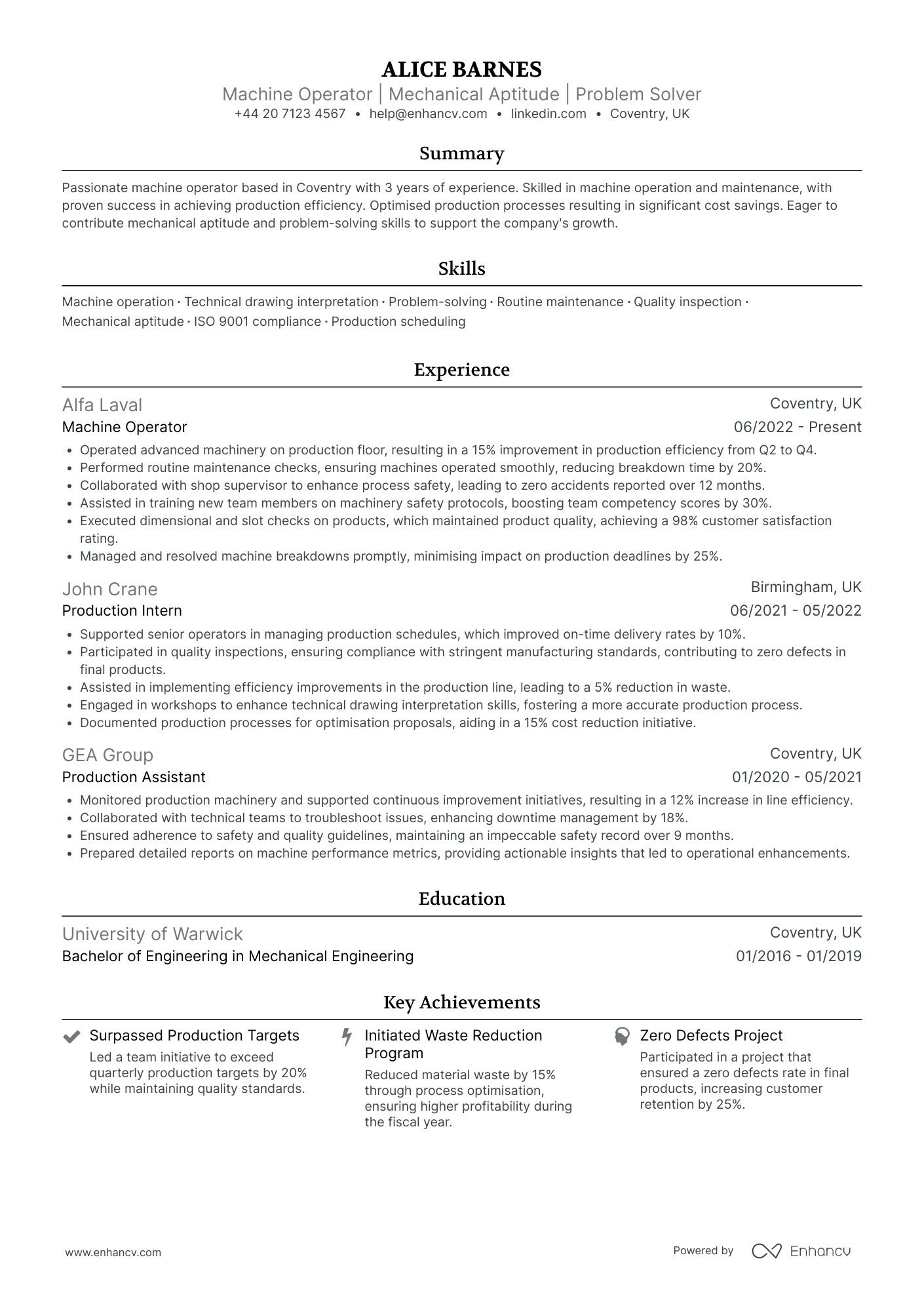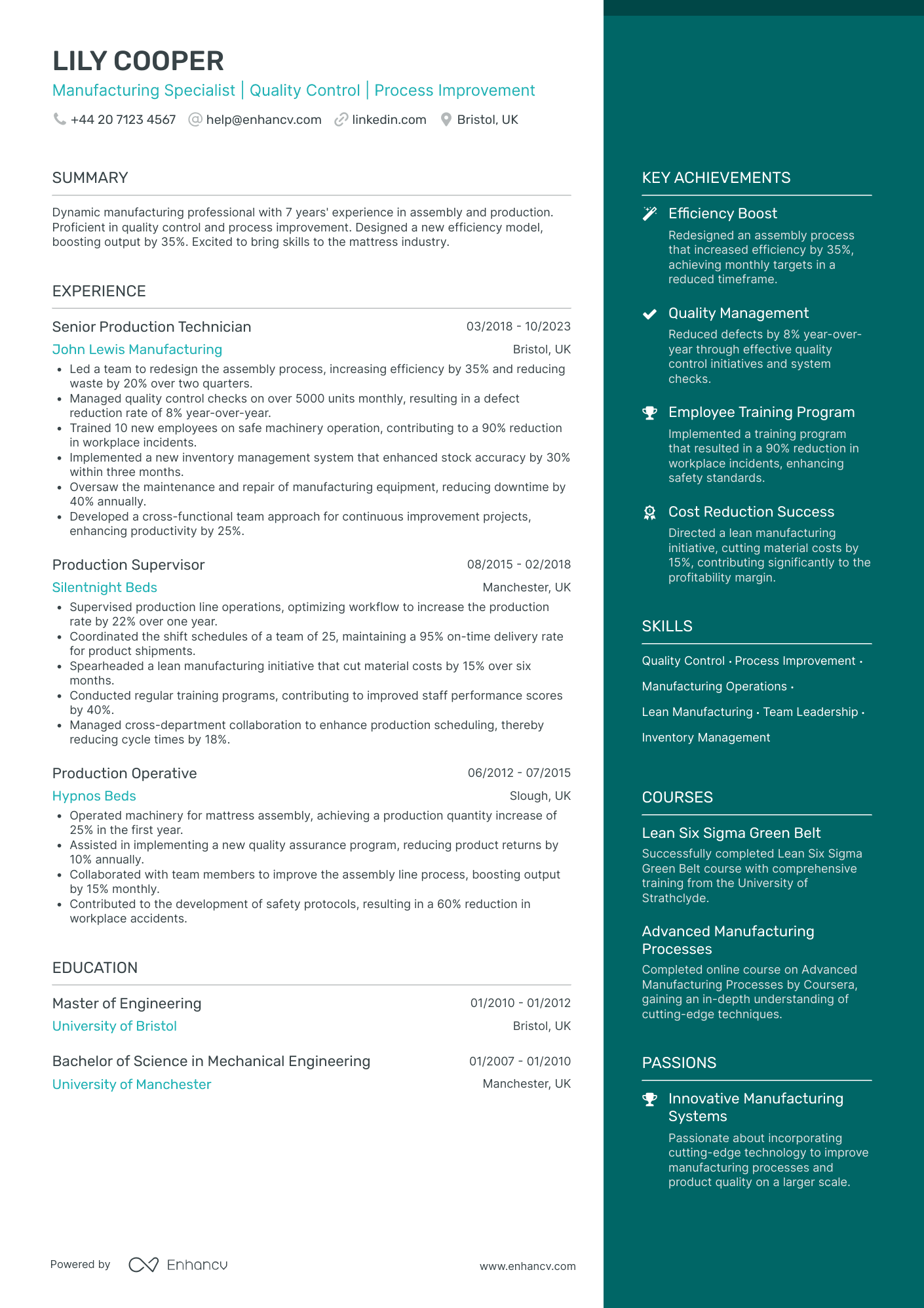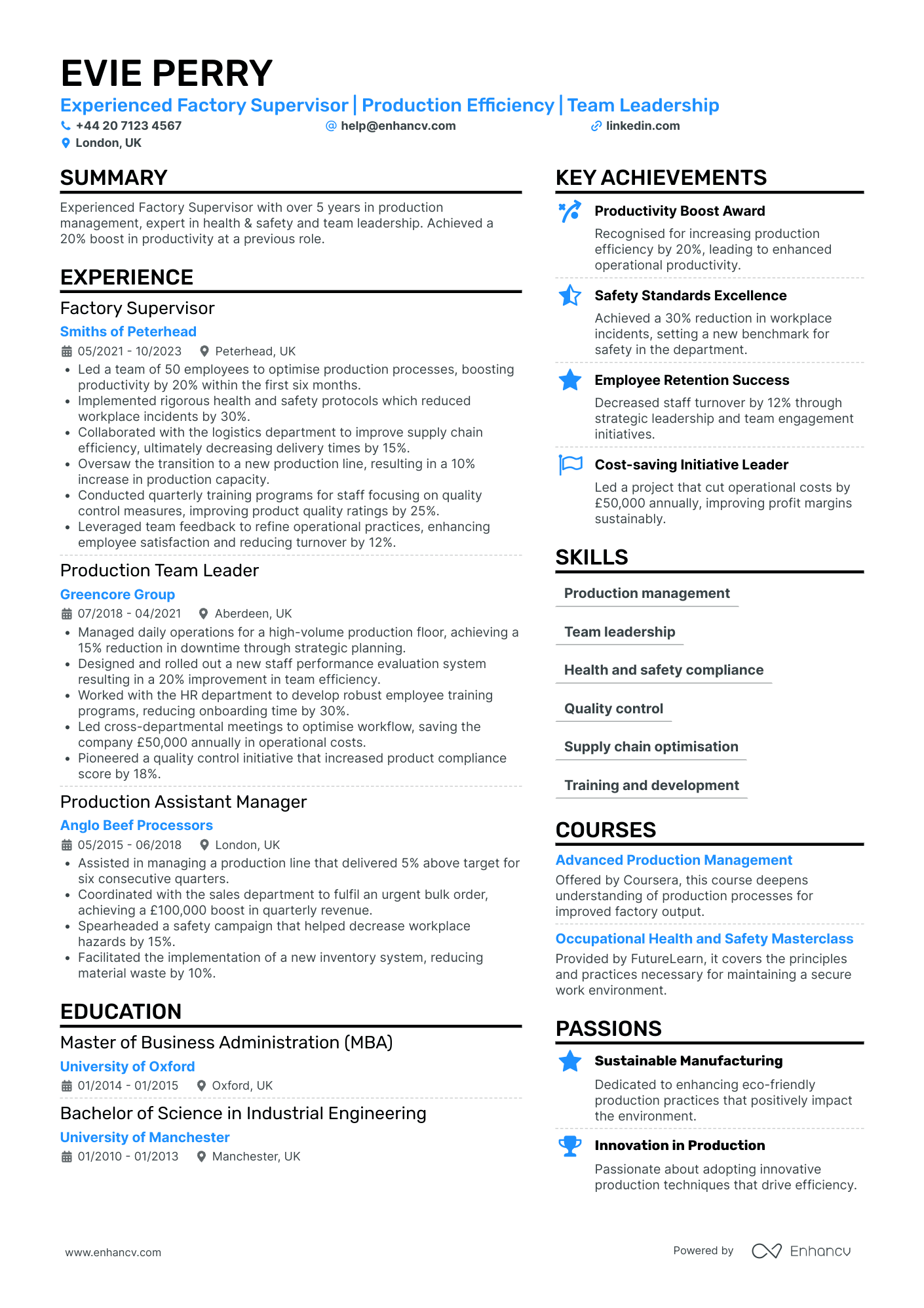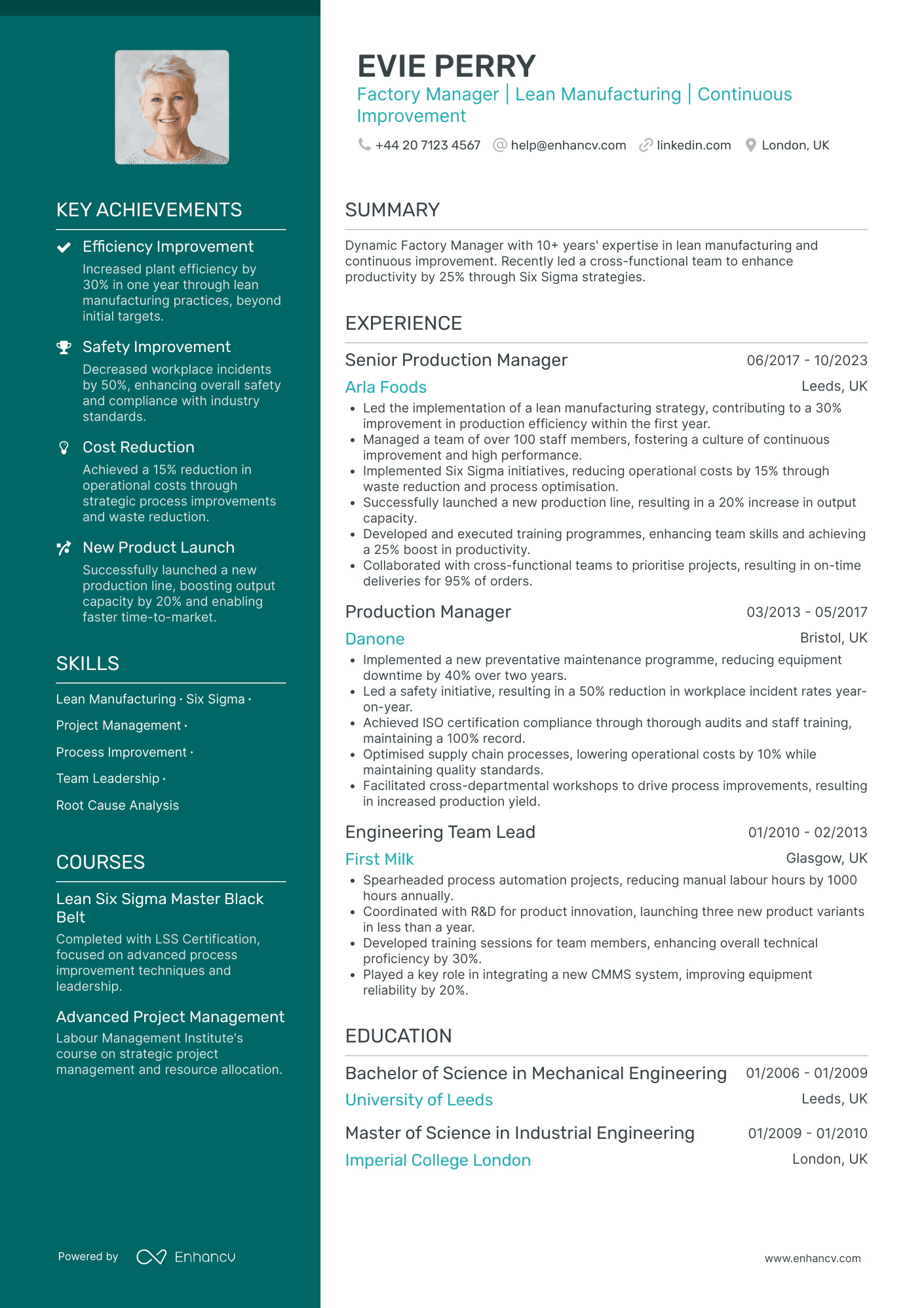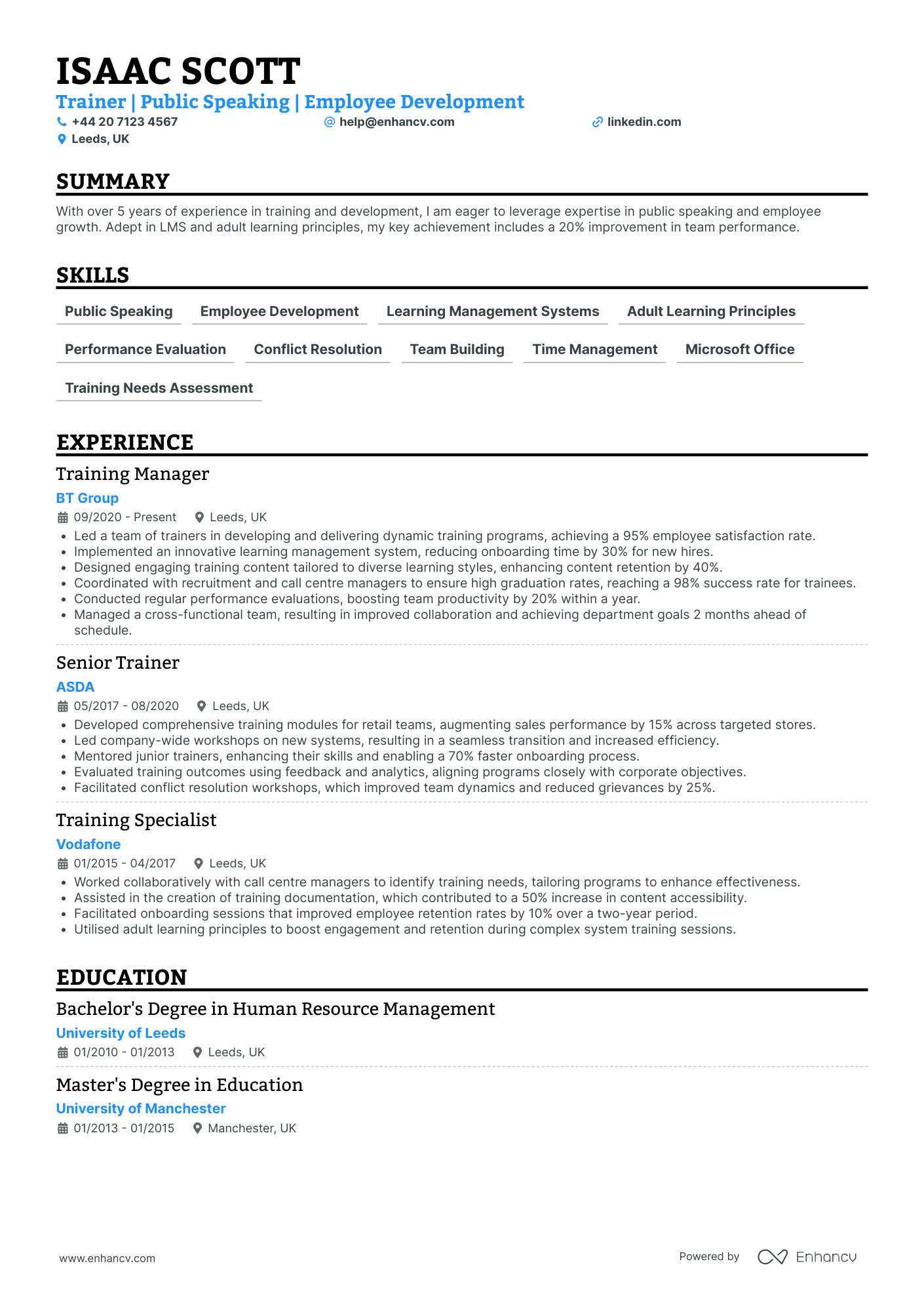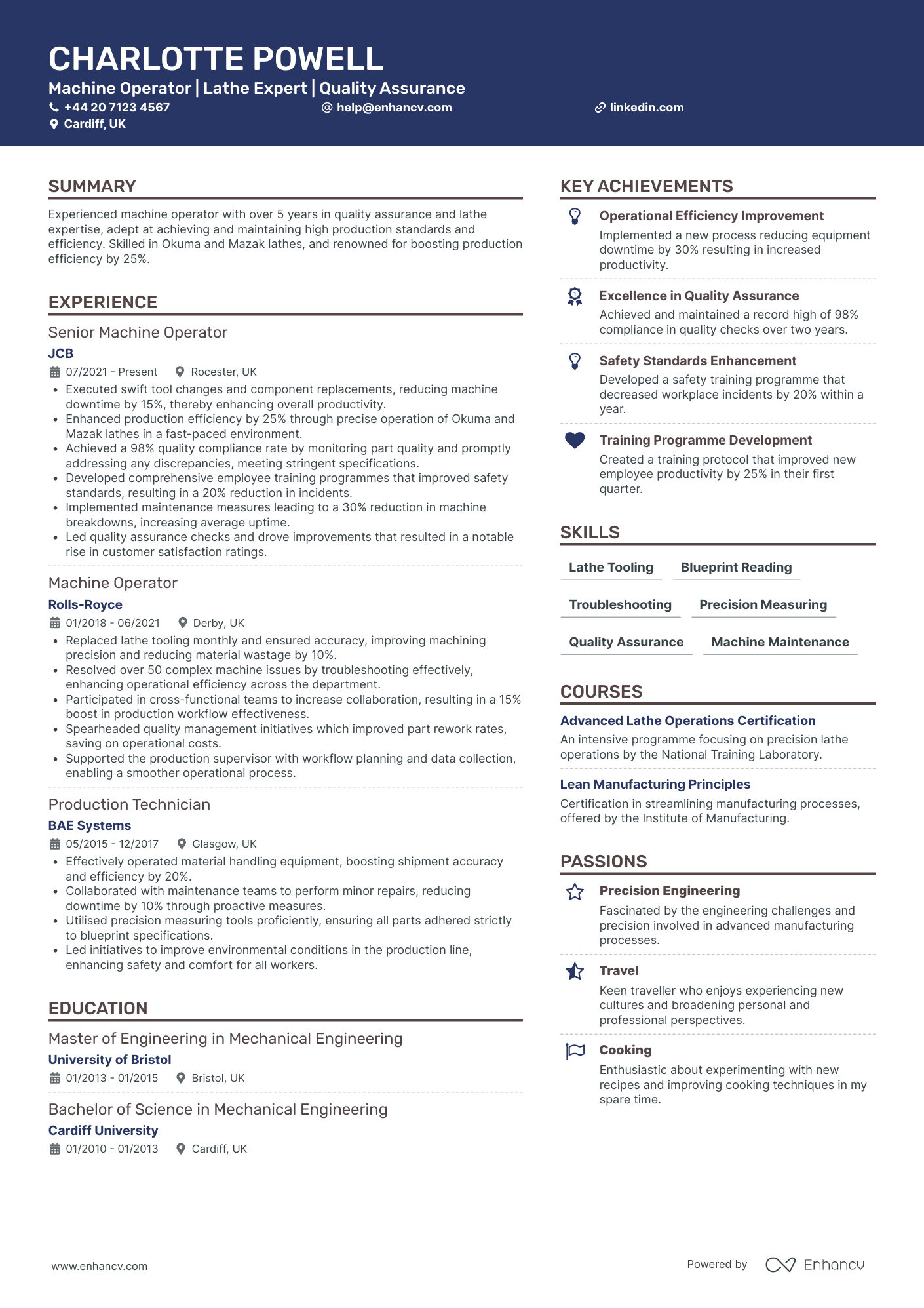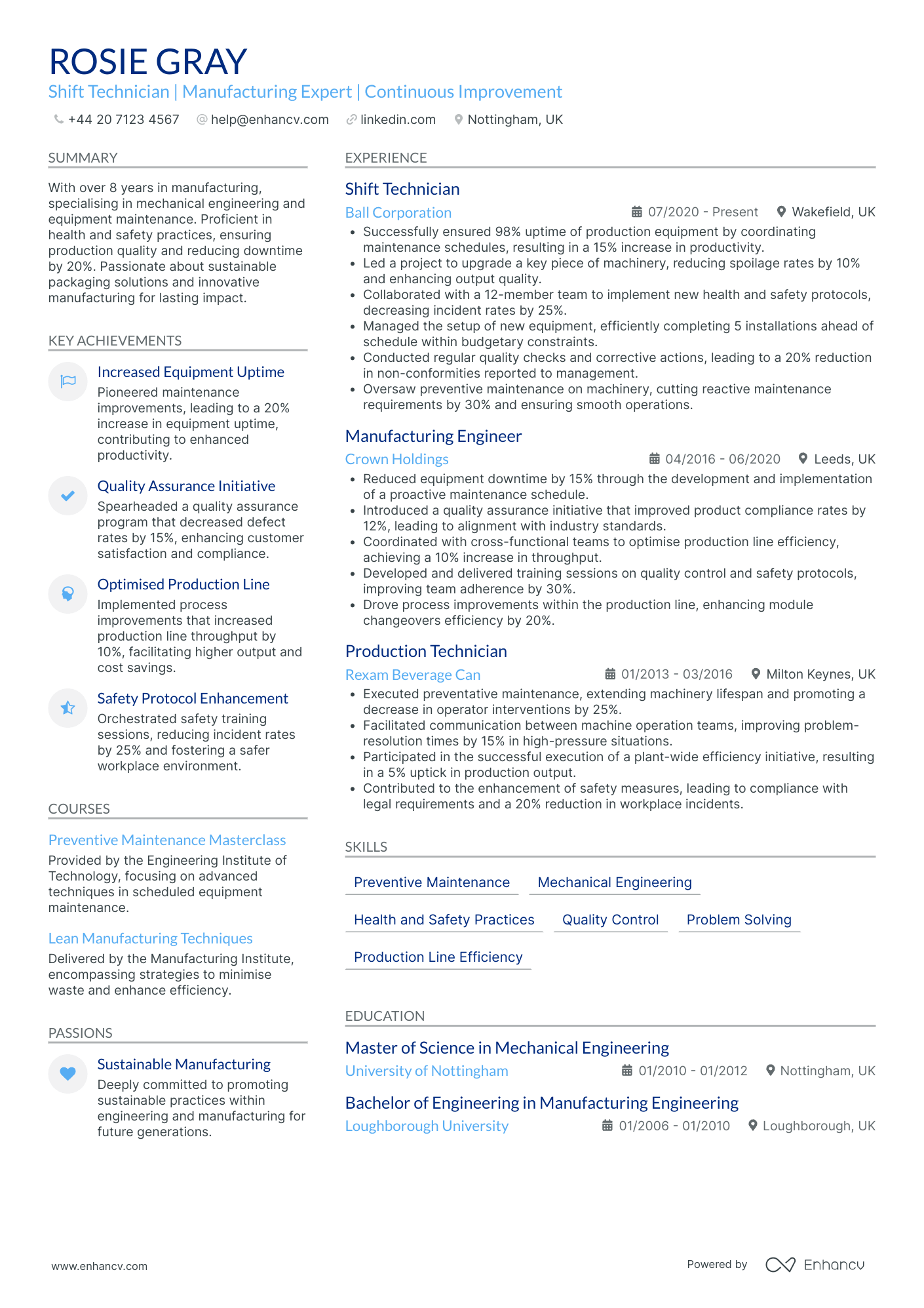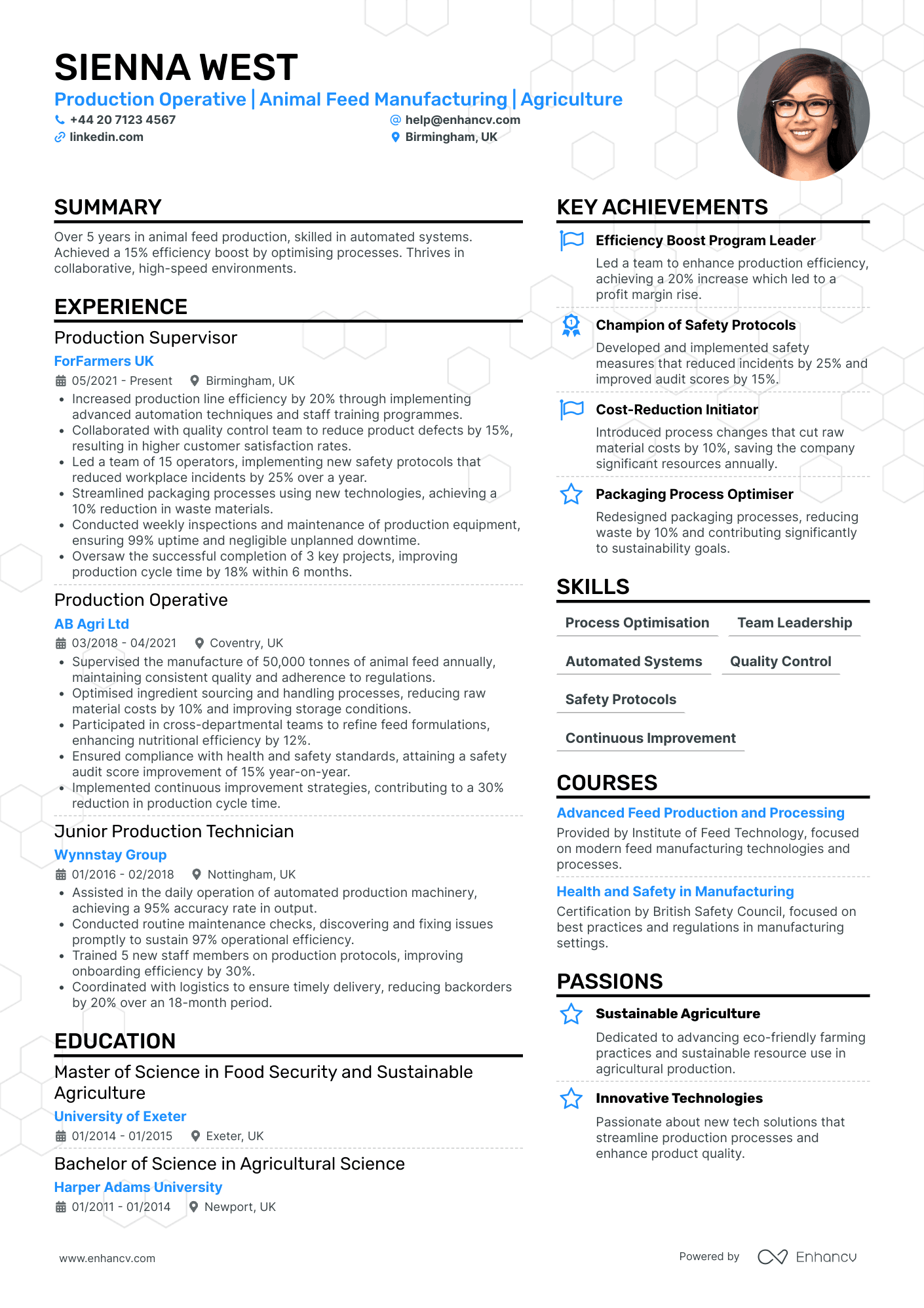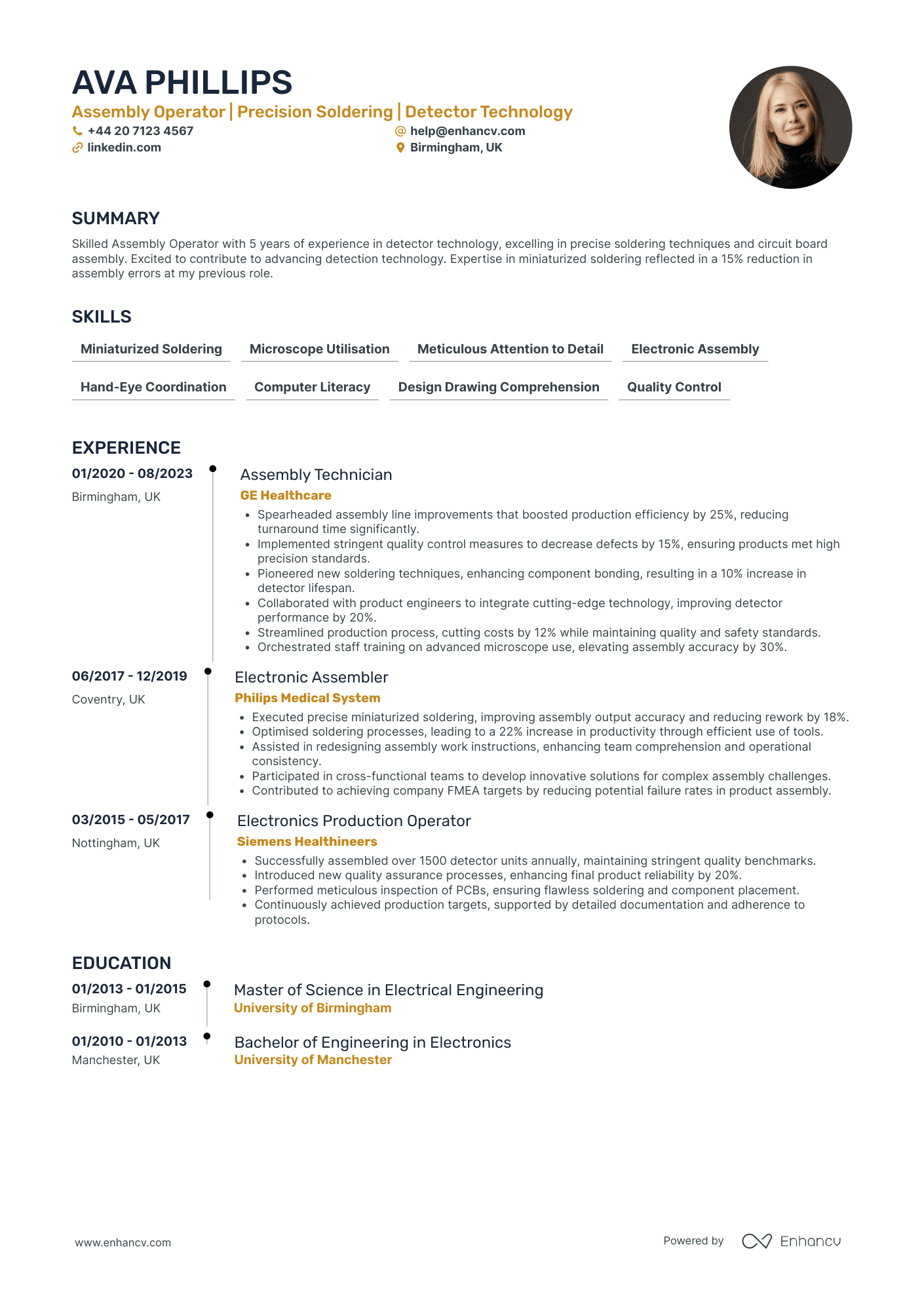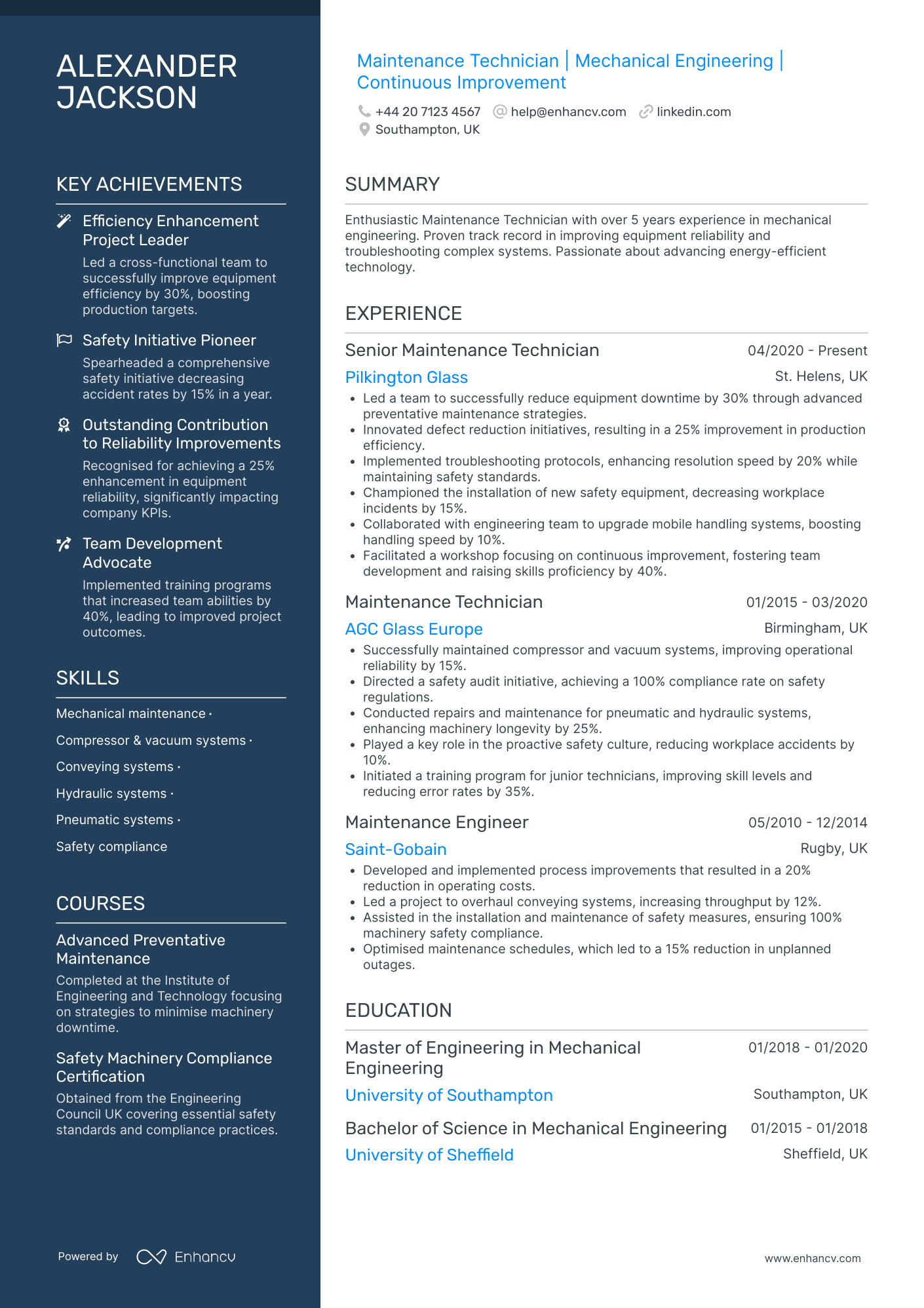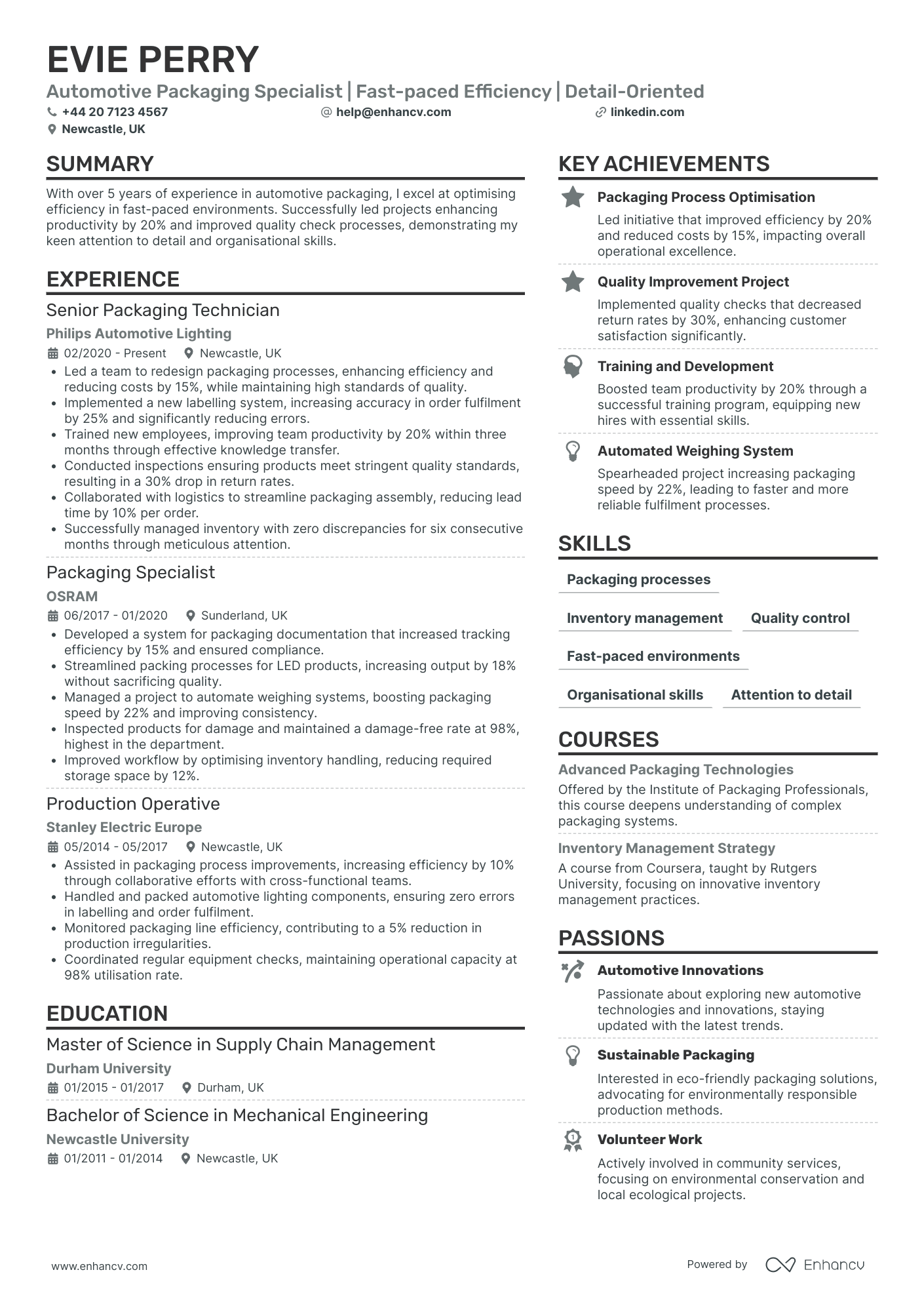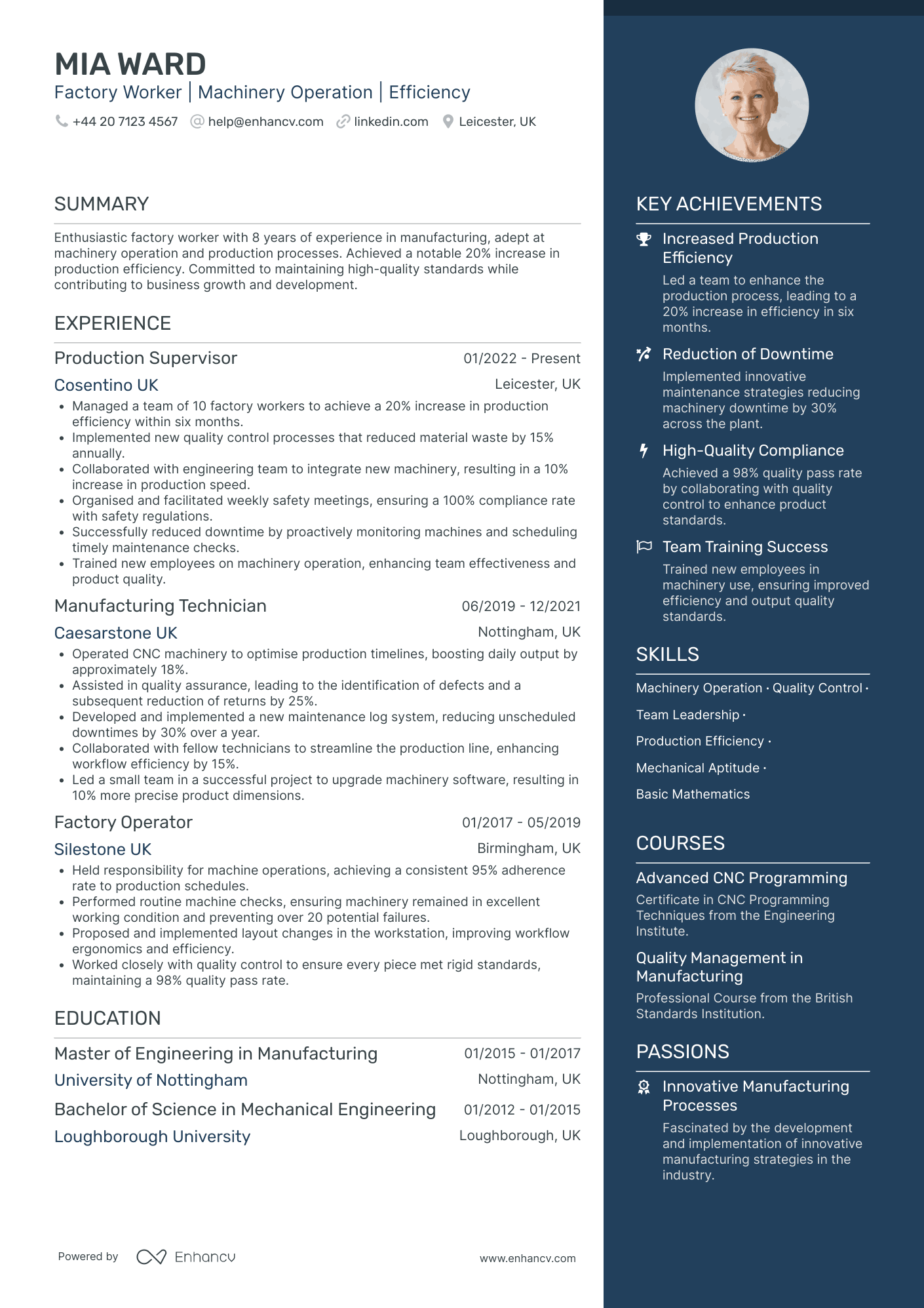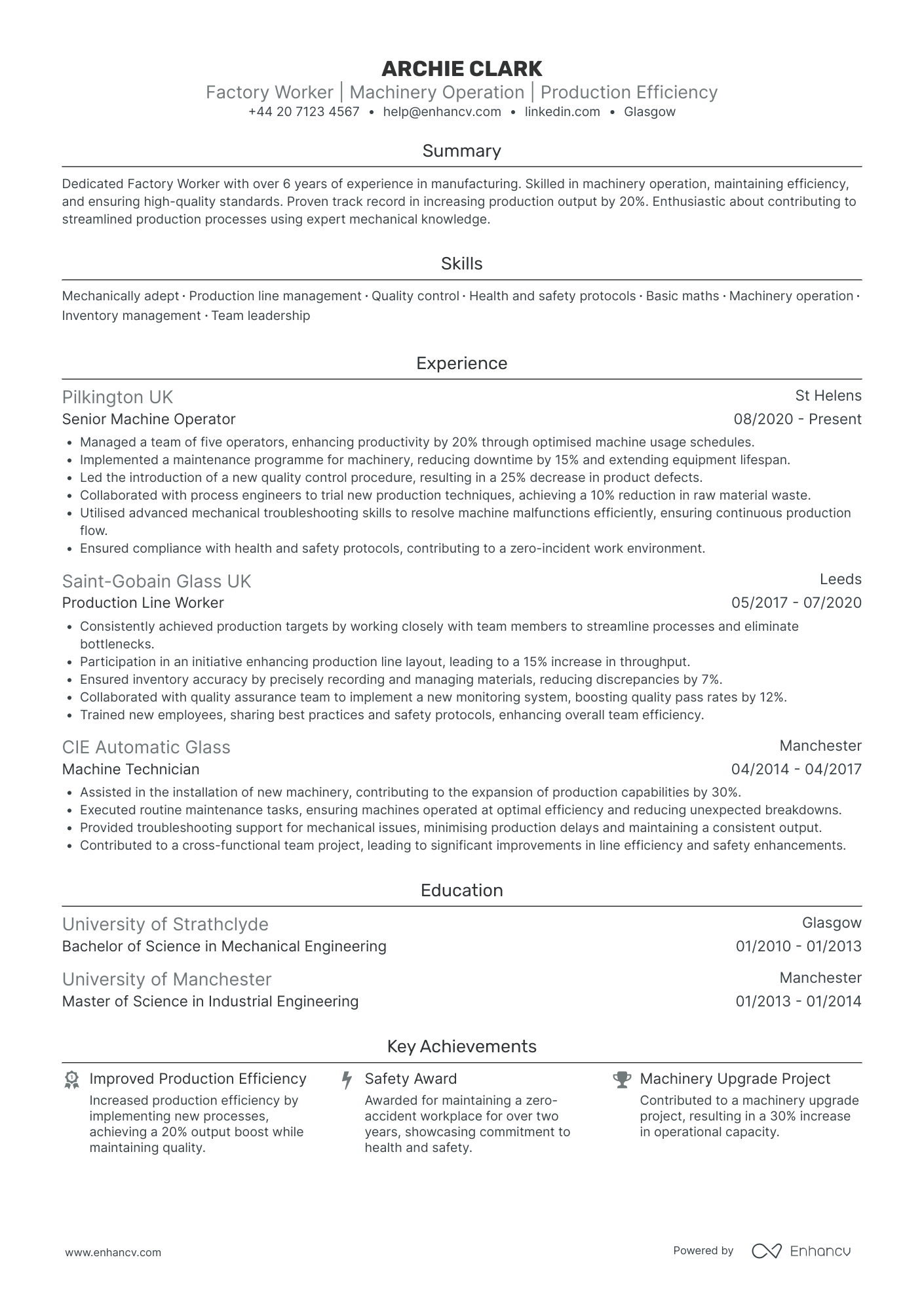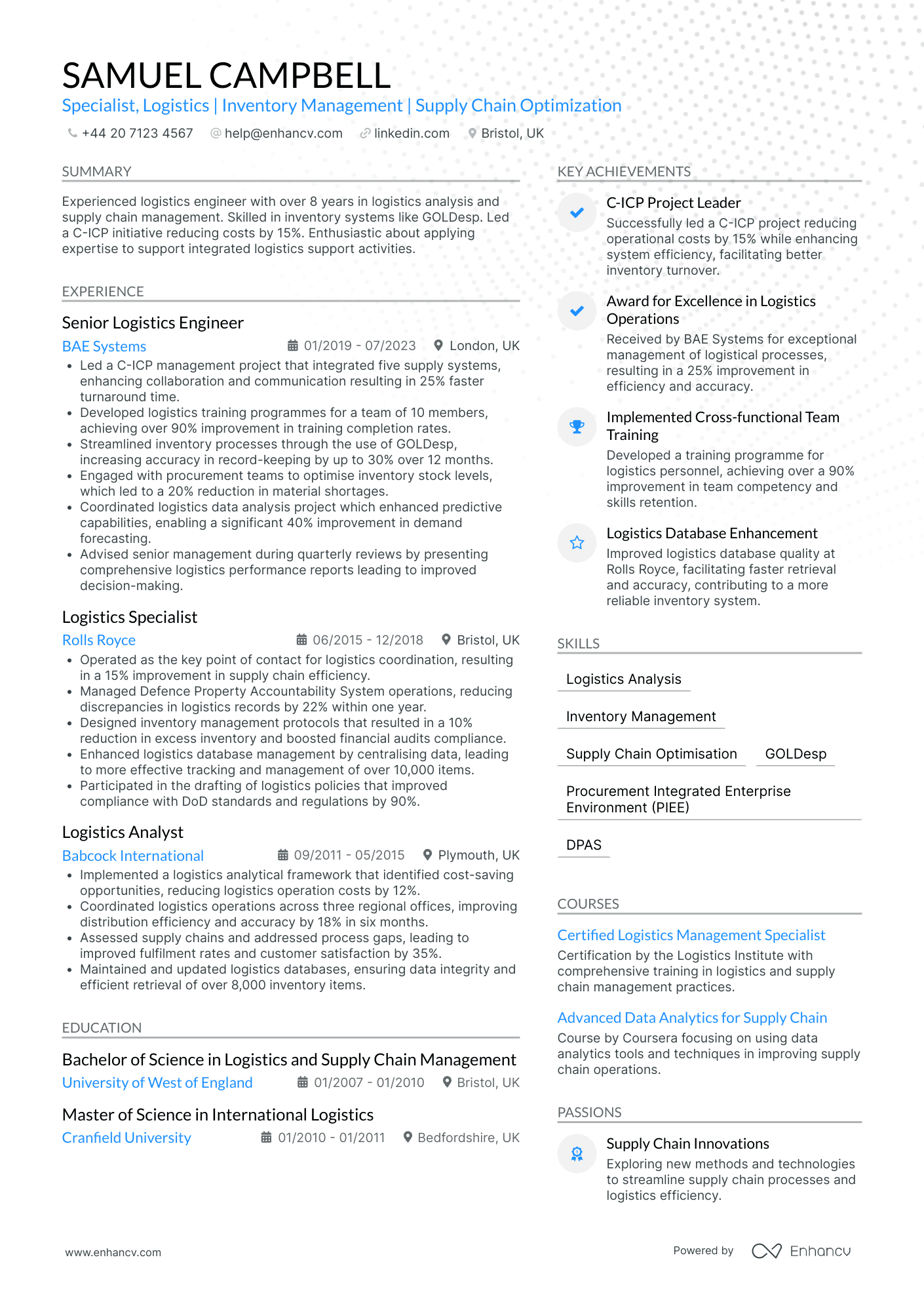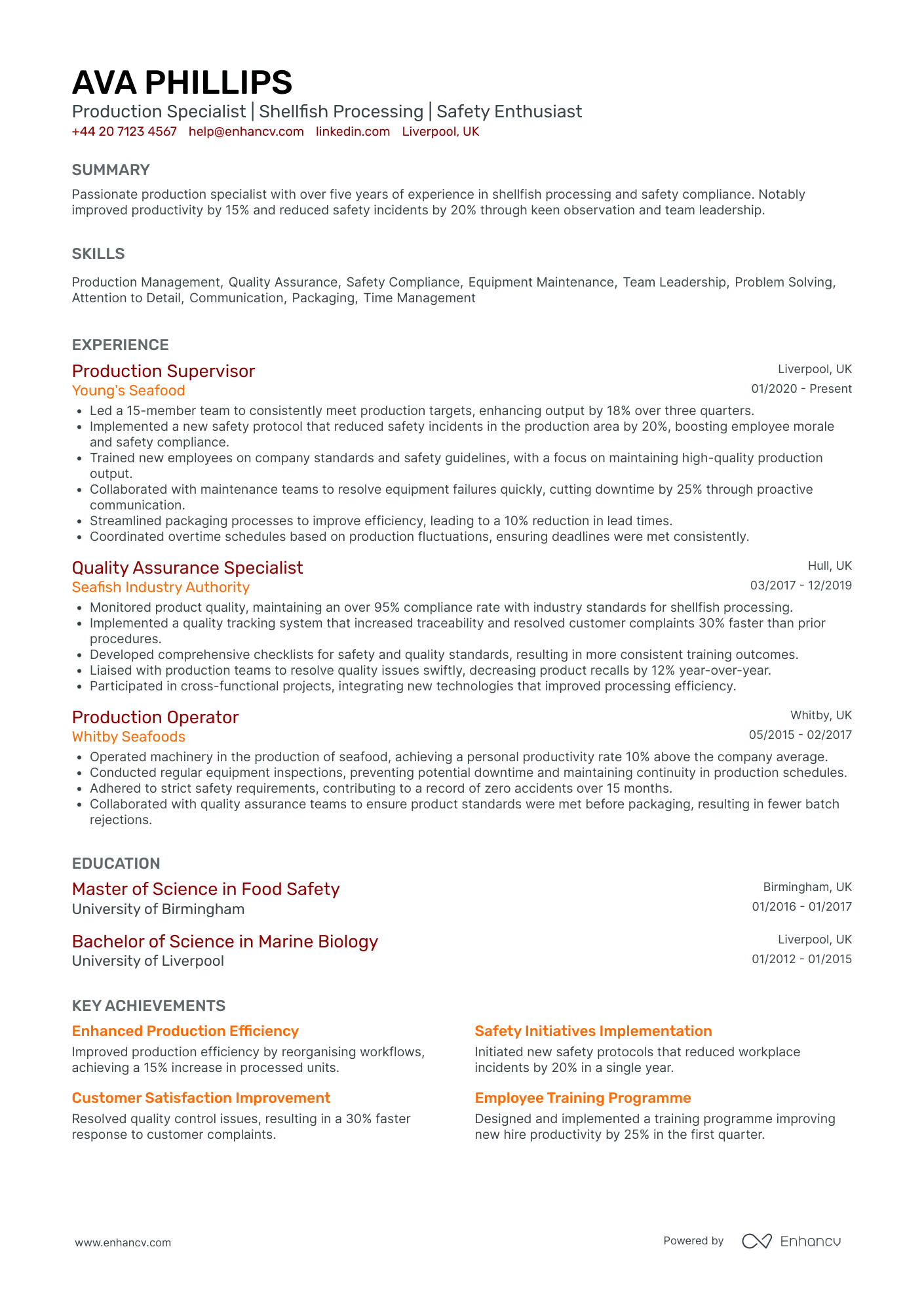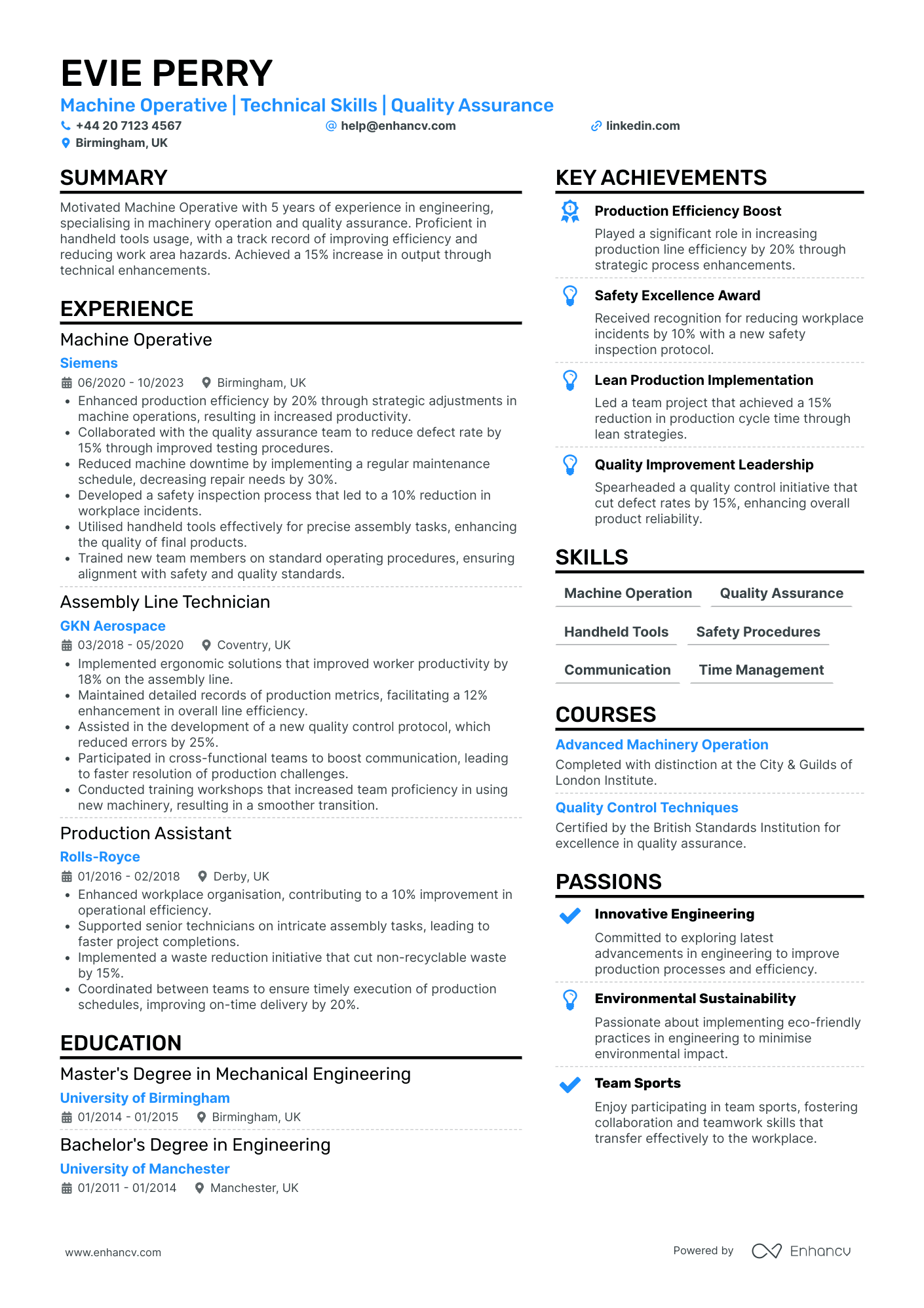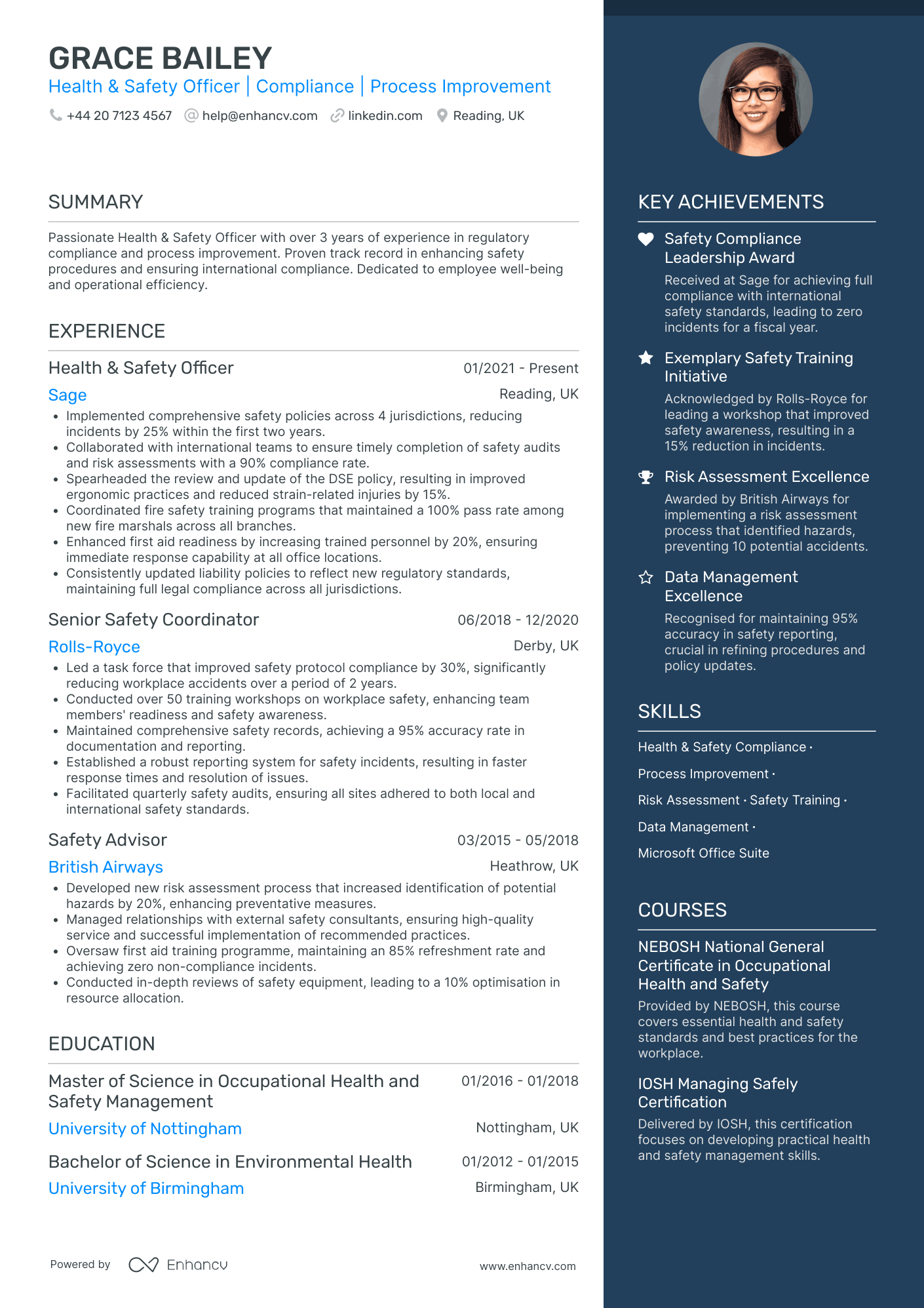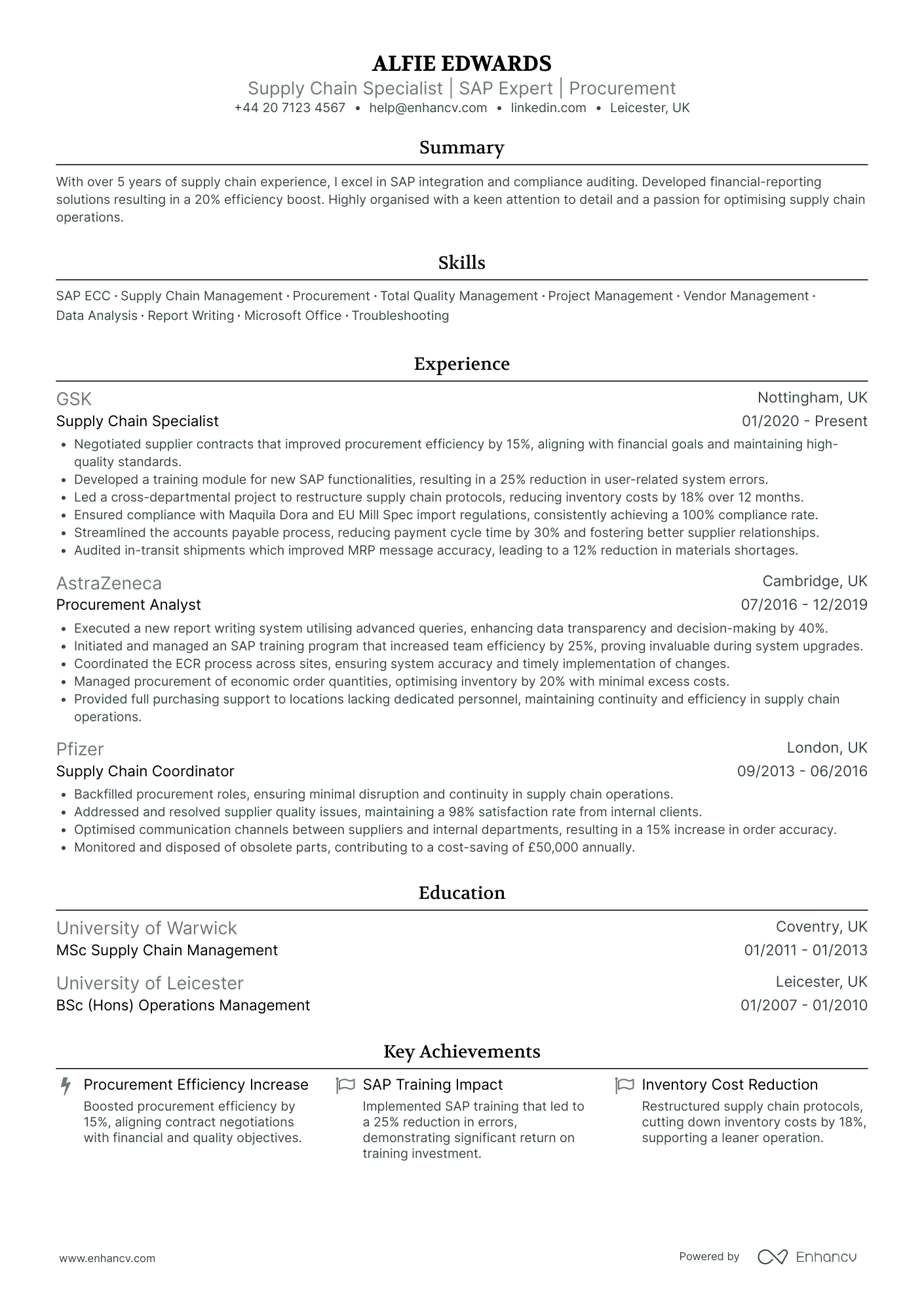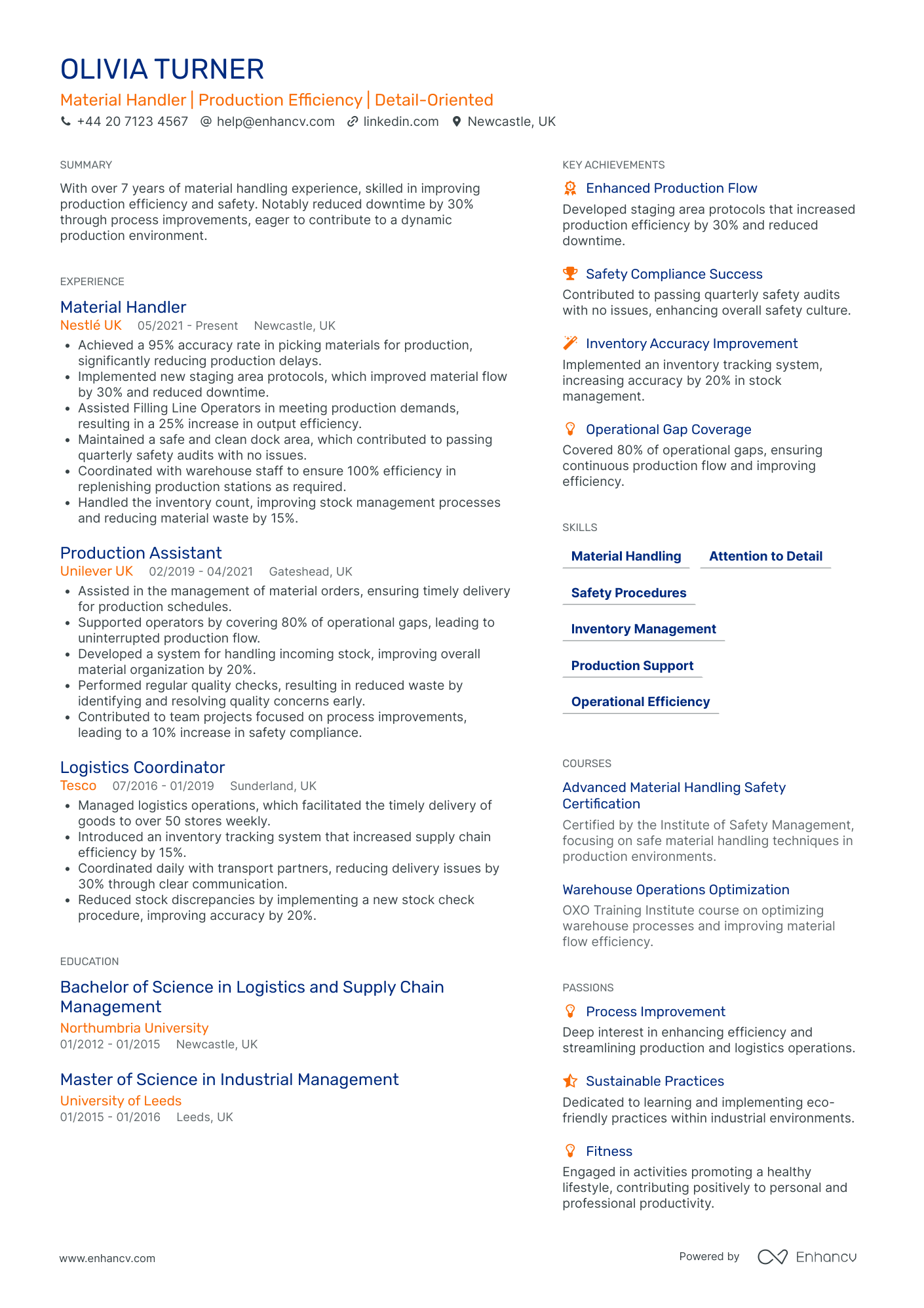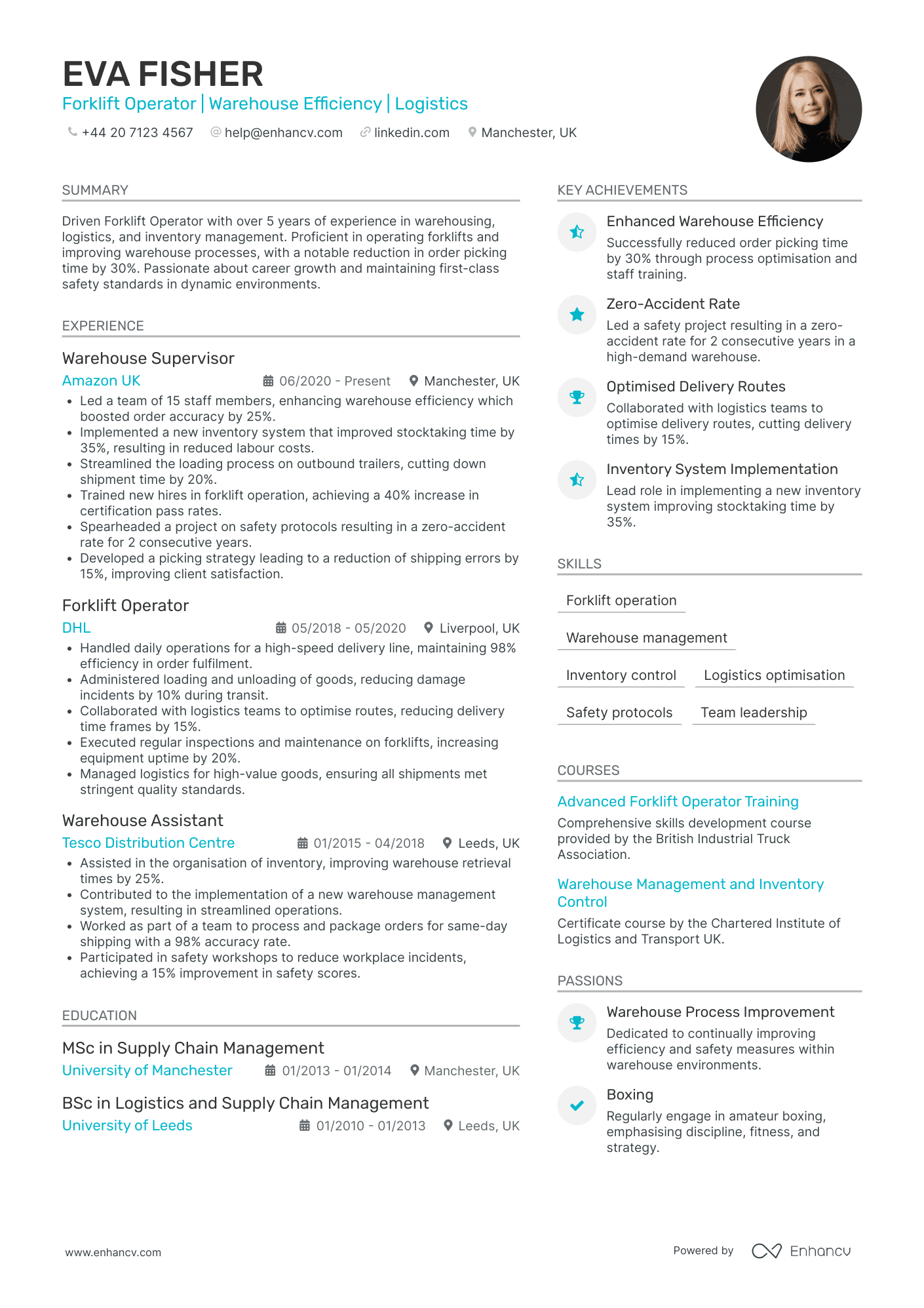Crafting a CV that effectively showcases your hands-on skills and experience can be daunting for factory workers. Our guide provides tailored tips to translate your technical abilities and accomplishments into a compelling narrative that resonates with employers.
- Applying the simplest CV design, so that recruiters can easily understand your expertise, skills, and professional background;
- Ensuring you stand out with your header, summary or objective statement, and a designated skills section;
- Creating your CV experience section - no matter how much expertise you have;
- Using real life professional CV examples to enhance the structure and outline of your profile.
If you still have no muse to write your professional CV, find some more industry-leading examples.
CV examples for factory worker
By Experience
Junior Factory Worker
- Concise and Well-Organized Presentation - The CV is laid out in a clear, logical structure, which makes it easy to navigate. Each section is concisely presented with focused bullet points that effectively communicate Alice Barnes's skills and experiences. The language is direct and professional, avoiding unnecessary jargon and thus maintaining clarity.
- Demonstrated Career Progression and Industry Commitment - Alice Barnes's career trajectory showcases a consistent climb within the manufacturing and engineering sectors, starting as a Production Intern moving on to a Production Assistant, and then advancing to a Machine Operator. Her career path reflects a steady growth in responsibilities and expertise, highlighting her dedication to the field.
- Quantifiable Achievements with Business Impact - The CV stands out due to its focus on measurable achievements that have had a direct impact on business performance. Examples include improving production efficiency by 15% and reducing machine breakdown time by 20%, which not only emphasize her technical competence but also demonstrate her ability to contribute significantly to organizational goals.
Senior Factory Worker
- Structured Career Progression - Lily Cooper's CV meticulously outlines a clear and upward career trajectory in the manufacturing industry. Starting as a Production Operative at Hypnos Beds and advancing to roles like Production Supervisor and finally Senior Production Technician at John Lewis Manufacturing, her professional growth is evident. Each position is complemented by escalating responsibilities that demonstrate her ability to adapt and excel within her field.
- Proven Impact through Quantifiable Achievements - The CV details significant, measurable outcomes stemming from Lily's initiatives. For example, Lily implemented a lean manufacturing strategy that reduced material costs by 15% and redesigned an assembly process to improve efficiency by 35%. These accomplishments not only highlight her problem-solving skills but also underscore her direct contribution to operational enhancements and profitability.
- Adaptable and Cross-Functional Expertise - The document underscores Lily's adaptability and her efficacy in cross-functional team settings. Her experience leading cross-department collaboration and training programs illustrates her ability to work effectively across various sectors of manufacturing operations. Her skills in implementing cross-functional approaches for continuous improvement projects indicate versatility and a strong capacity for teamwork and leadership.
Factory Supervisor
- Structured Presentation of Content - The CV is well-organized, with clearly defined sections that guide the reader through the candidate's qualifications and achievements. Each section is labeled and concise, allowing for quick comprehension of Evie Perry’s professional history, skills, and educational background.
- Consistent Career Advancement - Evie's career progression is clear and logical, showcasing a steady rise from a Production Assistant Manager to a Factory Supervisor within a prominent industry. This trajectory reflects a dedication to growth and the ability to take on increasingly complex responsibilities in production management.
- Leadership and Soft Skills Emphasis - The CV effectively highlights Evie’s leadership capabilities and soft skills, particularly in team management and health & safety compliance. The ability to lead a large team while also improving employee satisfaction and reducing turnover illustrates strong interpersonal skills and strategic leadership.
Factory Manager
- Structured Career Growth - The CV illustrates a clear career progression through increasingly responsible roles across prominent industry leaders like Arla Foods, Danone, and First Milk. This reflects the candidate's capability to take on more complex challenges, advance within the manufacturing sector, and contribute significantly to each organization.
- Proficient in Industry-Specific Methodologies - The use of Lean Manufacturing and Six Sigma is consistently detailed throughout the CV, demonstrating the candidate's technical depth and proficiency in advanced production optimization techniques. This expertise aligns well with the demands of the Factory Manager role, where efficiency and continuous improvement are critical.
- Quantifiable Achievements with Business Impact - The CV effectively communicates significant accomplishments that provide tangible business benefits, such as reducing operational costs by 15% and improving production efficiency by 30%. These achievements showcase the candidate’s ability to drive substantial improvements in industrial performance, aligning with strategic business objectives.
Factory Worker Trainer
- Compelling career trajectory and growth - Isaac Scott's CV outlines a clear progression from Training Specialist to Training Manager within a span of five years, reflecting significant career development. The ascension through reputable companies like Vodafone, ASDA, and BT Group highlights his growing expertise and leadership in the field of employee training and development.
- Strong blend of industry-specific methodologies - Showcasing a strong command over learning management systems and adult learning principles, Scott's CV underscores his proficiency in these educational frameworks, contributing to the effectiveness of training programs. His implementation of an innovative LMS that reduced onboarding time by 30% is a testament to his ability to leverage technological tools to enhance learning experiences.
- Notable achievements with business impact - The CV prominently features achievements that not only display statistical improvements but also connect those numbers to meaningful business outcomes. For instance, his initiative to create an innovative training program resulted in high employee satisfaction and a notable increase in team performance, which are critical to maintaining a motivated and productive workforce.
Factory Worker Team Lead
- Clear and Logical Structure - The CV is meticulously structured, starting with a concise and clear summary of the candidate’s skills and experiences. This ensures that recruiters can quickly identify Charlotte’s key qualifications and understand her expertise in the machine operations sector, particularly her specialization in lathe operations and quality assurance.
- Consistent Career Advancement in Engineering - Charlotte’s career trajectory shows a steady growth with increasing responsibilities, starting as a Production Technician and advancing to a Senior Machine Operator. The progression through prestigious companies like BAE Systems, Rolls-Royce, and JCB highlights her growing expertise in precision engineering and quality assurance roles.
- Deep Technical Expertise in Manufacturing Equipment - The inclusion of specific tools and machines such as Okuma and Mazak lathes demonstrates Charlotte’s deep technical understanding and hands-on experience. Her skill in utilizing advanced measurement tools like calipers and snap gauges reinforces her capability to maintain high production standards in the manufacturing industry.
Factory Worker Shift Manager
- Clear structure and focused content - The CV lays out all essential information in a coherent manner, presenting Rosie's qualifications, skills, and experiences in a logical progression. Each section is clearly labeled, ensuring easy navigation and highlighting her proficiency in mechanical engineering and continuous improvement.
- Demonstrated career progression - Rosie's career trajectory shows a dynamic growth path, advancing from Production Technician to Shift Technician while increasing responsibilities. This indicates her ability to take on more complex roles and showcases a deliberate upward movement within the manufacturing industry, driven by her expertise and accomplishments.
- Impactful achievements with business relevance - The CV effectively highlights Rosie's key achievements with specific metrics, such as reducing downtime by 20% and leading initiatives that decreased spoilage rates by 10%. These accomplishments underscore her contributions to enhancing efficiency, which directly translates to cost savings and improved production output for her employers.
By Role
Factory Production Worker
- Clear Structure and Conciseness in Content Presentation - The CV benefits from a logically structured format, where each section is clearly delineated and easy to navigate. Its conciseness ensures that only pertinent information is included, such as quantifiable results in each role. This enables a quick understanding of the candidate’s contributions and potential fit for the job.
- Demonstrates Career Trajectory and Industry Expertise - Sienna West's career progression, moving from a Junior Production Technician to a Production Supervisor, highlights her advancement through increasing levels of responsibility. The transition reflects not only her growth within the animal feed manufacturing sector but also her commitment to mastering her role in agriculture production.
- Highlights Impactful Achievements with Business Relevance - The CV not only lists accomplishments but places them in context, demonstrating their impact on business outcomes. For instance, implementing automation techniques and optimizing processes led to significant efficiency and cost improvements, which are critical metrics in a production setting. Such examples underscore her valuable contributions to the organizations she has worked with.
Factory Assembly Line Worker
- Structured Clarity and Coherence - The CV is well-organized, with clearly defined sections that make it easy to follow the candidate's career path and skills. This coherent structure ensures that essential details, such as the candidate's technical expertise and achievements, are highlighted effectively and concisely.
- Career Progression and Industry Specialization - This CV demonstrates a strong career trajectory within the field of healthcare technology assembly. The progression from Electronics Production Operator to Assembly Technician at leading companies like Siemens Healthineers, Philips Medical System, and GE Healthcare shows a steady growth in responsibilities and expertise within the specialized domain of detector technology.
- Technical Expertise and Innovation - Ava Phillips has a unique proficiency in advanced soldering techniques and quality control, underscored by implementing pioneering soldering methods that enhanced both product reliability and detector performance significantly. These industry-specific skills reflect a deep technical understanding that sets her apart in the field of precision electronics.
Factory Maintenance Worker
- Impressive career growth and industry commitment - Alexander's career trajectory shows a clear advancement from a Maintenance Engineer to a Senior Maintenance Technician. This not only highlights his commitment to the mechanical engineering field but also demonstrates his capability to take on increasing responsibilities in complex environments.
- Effective use of industry-specific methodologies - The CV effectively highlights Alexander's familiarity with advanced preventative maintenance strategies and troubleshooting protocols. His ability to innovate defect reduction initiatives and install safety equipment points to a deep technical understanding that is crucial for a Maintenance Technician role.
- Strong emphasis on leadership and development - Alexander's experience in spearheading team development initiatives and leading cross-functional teams showcases his leadership skills. His role in orchestrating workshops and training programs demonstrates his dedication to fostering a productive work environment, enhancing team skills, and ensuring safety compliance.
Factory Packing Worker
- Strategic Career Advancement - Evie Perry’s career trajectory is well-delineated, indicating a clear path of growth. From a Production Operative to a Senior Packaging Technician, each role signifies a step-up in responsibility and impact within the automotive packaging sector, showcasing deliberate and strategic career advancements.
- Emphasis on Industry-Specific Methodologies - The CV underlines Evie’s expertise in industry-standard techniques such as the implementation of new labeling systems and the automation of weighing systems. These technical elements highlight her proficiency in utilising cutting-edge methodologies to enhance packaging efficiency and accuracy, which are vital in automotive packaging.
- Demonstrates Leadership and Training Skills - Evie’s prowess in soft skills is exemplified by her leadership in training new employees, fostering team productivity improvements by 20% in a short time. This indicates her strong ability to effectively communicate and impart knowledge, thereby enhancing team performance and cohesion.
Factory Quality Control Worker
- Comprehensive Career Progression - The CV showcases a clear and logical career trajectory, moving from a Factory Operator to a Production Supervisor. Each role highlights the progression in responsibility and skills, indicating the candidate's growth and leadership development within the manufacturing sector.
- Strong Emphasis on Achievements - Each position in the experience section is detailed with specific, measurable achievements. These accomplishments are not just numbers; they reflect significant improvements in production efficiency, waste reduction, and machine uptime, demonstrating the candidate's direct impact on business operations and profitability.
- Technical Proficiency and Industry Knowledge - The CV highlights the candidate's depth in technical skills pertinent to manufacturing, such as CNC machinery operation, maintenance scheduling, and quality control processes. The inclusion of advanced coursework and certifications further enhances her technical credibility, showcasing a commitment to professional development in industry-specific methodologies.
Factory Operations Worker
- Clarity and Structure Enhance Readability - The CV is well-organized, with clearly defined sections allowing for easy navigation. The use of bullet points in the experience section effectively highlights key achievements and responsibilities, ensuring that essential details are communicated concisely and clearly.
- Impressive Career Progression - Archie's career trajectory is marked by consistent growth from a Machine Technician to a Senior Machine Operator. This advancement illustrates a commitment to professional development and an increasing level of responsibility, showcasing a successful career path within the manufacturing industry.
- Emphasis on Safety and Efficiency Achievements - The CV notably highlights achievements that have directly impacted business success, such as improving production efficiency by 20% and maintaining a zero-incident work environment. These accomplishments not only underscore Archie's expertise but also his ability to drive meaningful change and improvements within his role.
Factory Logistics Worker
- Clear Structure and Focused Content - The CV is structured in a clear and logical manner, with sections dedicated to each key aspect of the candidate’s background, such as professional experience, education, and skills. This organization makes the information readily accessible and easy to digest, allowing employers to quickly identify Samuel’s qualifications in logistics and supply chain management.
- Impressive Career Growth and Experience in Leading Companies - Samuel Campbell's career trajectory is marked by steady growth and increasing responsibility. From a Logistics Analyst at Babcock International to a Senior Logistics Engineer at BAE Systems, the candidate has progressively taken on more complex roles, showcasing a successful climb in the logistics and supply chain management field. This demonstrates his ability to adapt and excel in different organizational contexts.
- Industry-specific Expertise and Technical Proficiency - The CV stands out with its detailed mention of industry-specific tools and methodologies such as GOLDesp and the Defence Property Accountability System. This technical depth, coupled with experience in predictive analytics and procurement strategies, highlights Samuel’s capability to leverage cutting-edge technologies to optimize supply chain operations.
Factory Processing Worker
- Structured and Concise Presentation - The CV effectively organizes multiple sections like experience, education, skills, and certifications, ensuring clarity and readability. Each element is concisely described, focusing on key responsibilities and results, allowing easy assimilation of the candidate's strengths.
- Consistent Career Growth in Relevant Industry - Demonstrating a clear upward trajectory, Ava Phillips has progressed from a Production Operator to a Production Supervisor within the shellfish processing industry. This growth highlights her increasing responsibilities and expertise in leading teams and managing production processes effectively.
- Focus on Safety and Process Efficiency - Ava's background shows a crucial focus on improving safety protocols and streamlining production efficiencies. Her track record in reducing safety incidents by 20% and increasing productivity by 15% reflects her commitment to creating a safer and more efficient work environment, underlining her industry-specific proficiency.
Factory Machine Operator Worker
- Effective Content Presentation - The CV stands out with its clear and structured presentation, making it easy to navigate through different sections. Each element is concisely described, providing a quick yet comprehensive overview of the candidate's qualifications and accomplishments, maintaining a focus on relevance to the job title throughout.
- Demonstrated Career Progression - Evie Perry's career trajectory reflects a steady growth in the engineering field, advancing from a Production Assistant to increasingly responsible roles as an Assembly Line Technician and then a Machine Operative. This progression highlights her ability to take on greater responsibilities and deliver impactful results, indicative of her professional development.
- Emphasis on Industry-Specific Methodologies - The CV emphasizes unique industry-specific skills such as machine operation, quality assurance, and ergonomic assessment, showcasing the technical depth the candidate brings to machinery operation and quality management. Training in advanced machinery operation and quality control techniques reinforces her expertise.
Factory Safety Officer Worker
- Logical Organization of Sections - Grace Bailey's CV is presented in a structured manner, with distinct sections for experience, education, skills, courses, and achievements. This clarity aids in quickly assessing her qualifications. The conciseness of bullet points effectively communicates her accomplishments and responsibilities without overwhelming the reader.
- Progressive Career Development - Grace's career trajectory demonstrates steady growth, with promotions from a Safety Advisor at British Airways to a Senior Safety Coordinator at Rolls-Royce and then to a Health & Safety Officer at Sage. This progression indicates her strong performance and increasing responsibility in the field of health and safety.
- Significant Industry-Specific Expertise - Her CV highlights her proficiency with industry-relevant methodologies like comprehensive safety policies, risk assessments, fire safety training, and DSE assessments. This technical depth showcases her ability to apply specialized knowledge in real-world settings, ensuring compliance and optimizing safety protocols.
Factory Supply Chain Worker
- Clear and Structured Presentation - The CV is meticulously organized with distinct sections for experience, education, skills, achievements, and passions. This structure facilitates easy navigation, ensuring that key information is accessible at a glance, which is vital for making a strong first impression.
- Effective Showcase of Career Growth - Alfie Edwards demonstrates a consistent career progression through increasingly responsible roles within renowned companies like GSK, AstraZeneca, and Pfizer. This trajectory evidences not only growth in responsibilities but also an expansion of expertise across various crucial areas of supply chain management and procurement.
- In-Depth Technical Proficiency - The CV highlights Alfie's strong command of industry-specific tools and methodologies, particularly SAP ECC and advanced procurement strategies. Such technical depth showcases his capability to drive efficiencies and improvements in complex supply chain environments, underscoring his potential value to employers.
Factory Material Handler Worker
- Structures career progression with a focus on growth and diversification - Olivia Turner’s CV demonstrates a well-defined career trajectory, showcasing her transition from a Logistics Coordinator at Tesco to a Material Handler at Nestlé UK. Her roles highlight increasing responsibilities and industry shifts, reflecting her dynamic adaptability and determination to excel within logistics and production environments.
- Emphasizes industry-relevant skills and certifications - The CV effectively highlights Olivia's industry-specific expertise, such as the Advanced Material Handling Safety Certification and Warehouse Operations Optimization course. These credentials underscore her proficiency in handling material efficiently and safely, ensuring alignment with production and logistics standards.
- Conveys meaningful accomplishments with measurable impact - Olivia’s achievements section powerfully illustrates her contributions by detailing the tangible improvements in production efficiency and safety compliance. By quantifying accomplishments, such as a 30% increase in production flow efficiency, the CV presents her impact meaningfully in terms of business relevance.
Factory Forklift Operator Worker
- Focused Career Path with Consistent Growth - Eva Fisher's career trajectory is impressive, demonstrating steady growth from a Warehouse Assistant to a Supervisor role at Amazon UK. This progression reflects her dedication to her field and her ability to adapt and take on increasing responsibilities, crucial for a leadership position in warehousing and logistics.
- Strong Foundation in Warehouse and Logistics Efficiency - The CV includes specific elements such as inventory system implementation and forklift operation, highlighting a practical and technical understanding of warehouse efficiency. Describing these tools and methodologies offers insights into her ability to handle industry-specific challenges effectively, such as optimizing stocktaking and shipment times.
- Significant Achievements Reflecting Business Impact - The CV not only lists achievements but frames them in context with their business impact, such as boosting order accuracy by 25% and achieving a zero-accident rate. These accomplishments are tied directly to tangible improvements in operational efficiency and safety, vital for a role that oversees warehouse logistics and processes.
How complex should the format of your factory worker CV be?
Perhaps, you decided to use a fancy font and plenty of colours to ensure your factory worker CV stands out amongst the pile of other candidate profiles. Alas - this may confuse recruiters. By keeping your format simple and organising your information coherently, you'll ultimately make a better impression. What matters most is your experience, while your CV format should act as complementary thing by:
- Presenting the information in a reverse chronological order with the most recent of your jobs first. This is done so that your career history stays organised and is aligned to the role;
- Making it easy for recruiters to get in touch with you by including your contact details in the CV header. Regarding the design of your CV header, include plenty of white space and icons to draw attention to your information. If you're applying for roles in the UK, don't include a photo, as this is considered a bad practice;
- Organising your most important CV sections with consistent colours, plenty of white space, and appropriate margins (2.54 cm). Remember that your CV design should always aim at legibility and to spotlight your key information;
- Writing no more than two pages of your relevant experience. For candidates who are just starting out in the field, we recommend to have an one-page CV.
One more thing about your CV format - you may be worried if your double column CV is Applicant Tracker System (ATS) complaint. In our recent study, we discovered that both single and double-column CVs are ATS-friendly . Most ATSes out there can also read all serif and sans serif fonts. We suggest you go with modern, yet simple, fonts (e.g. Rubik, Lato, Raleway) instead of the classic Times New Roman. You'll want your application to stand out, and many candidates still go for the classics. Finally, you'll have to export your CV. If you're wondering if you should select Doc or PDF, we always advise going with PDF. Your CV in PDF will stay intact and opens easily on every OS, including Mac OS.

PRO TIP
For certain fields, consider including infographics or visual elements to represent skills or achievements, but ensure they are simple, professional, and enhance rather than clutter the information.

The top sections on a factory worker CV
- Relevant Work Experience explains past factory roles.
- Key Skills section showcases specific manufacturing abilities.
- Safety Certifications demonstrate commitment to workplace safety.
- Machinery Proficiency highlights experience with factory equipment.
- Production Targets Met shows quantifiable work achievements.

What recruiters value on your CV:
- Emphasise your physical stamina and ability to work in a demanding environment, showcasing experience with long shifts or physically intensive tasks relevant to factory work.
- Highlight specific machinery or equipment you are proficient with, as factory roles often require the operation of specialised tools and technology.
- Demonstrate your understanding of health and safety protocols in a factory setting, including any certifications you possess such as for manual handling or safety compliance.
- Detail your teamwork and communication skills, giving examples of previous collaboration with colleagues to meet production targets or improve processes.
- Include any experience with quality control, providing instances where you have inspected and ensured the quality of products in a previous factory role.
Recommended reads:
Our checklist for the must-have information in your factory worker CV header
Right at the very top of your factory worker CV is where you'd find the header section or the space for your contact details, headline, and professional photo. Wondering how to present your the name of the city you live in and the country abbreviation as your address;
- are tailored to the role you're applying for by integrating key job skills and requirements;
- showcase what your unique value is, most often in the form of your most noteworthy accomplishment;
- select your relevant qualifications, skills, or current role to pass the Applicant Tracker System (ATS) assessment. Still not sure how to write your CV headline? Our examples below showcase best practices on creating effective headlines:

Examples of good CV headlines for factory worker:
- Production Line Operative | Lean Manufacturing Expert | NVQ Level 2 | 5+ Years Experience
- Skilled Machine Technician | CNC Programming | City & Guilds Certified | 10 Years on the Job
- Assembly Line Worker | Quality Control Pro | Forklift Licence | Committed to Safety | 3 Years
- Senior Process Operator | Chemical Batch Production | ISO Standards | HNC Qualified | 15 Years
- Junior Manufacturing Associate | Apprentice-Trained | Mechanical Aptitude | Team Player | Continuous Learning
- Plant Maintenance Engineer | Electrical Systems Expert | HND in Engineering | 12 Years in Heavy Industry
What's the difference between a factory worker CV summary and objective
Why should it matter to you?
- Your factory worker CV summary is a showcasing your career ambitions and your unique value. Use the objective to answer why your potential employers should hire you based on goals and ambitions. The objective is the ideal choice for candidates who happen to have less professional experience, but still meet some of the job requirements.
Before you select which one will be more relevant to your experience, have a look at some industry-leading CV summaries and objectives.

CV summaries for a factory worker job:
- Highly-dedicated factory worker with over 7 years of experience in fast-paced assembly line work, proven track record of exceeding production targets at ABC Manufacturing Ltd. Skilled in operating heavy machinery and maintaining a relentless focus on quality control. Awarded ‘Employee of the Year’ for significantly reducing downtime.
- Exceptional team player with a robust background in automotive parts production, amassing 5 years of experience. Proficient in lean manufacturing techniques and adept at using advanced fabrication tools. Managed a departmental efficiency increase of 20% through process optimisation at XYZ Auto Parts.
- Former warehouse supervisor eager to apply a decade of logistic management skills to a new challenge in the production sector. Adept at coordinating large teams and streamlining processes for efficiency, ready to leverage extensive know-how to boost operational productivity and worker satisfaction in a factory setting.
- Accomplished sales manager transitioning to the manufacturing industry, bringing 8 years of team leadership and strategic planning experience. Excited to harness problem-solving abilities and customer service expertise to enhance production line efficiency and product quality.
- Entry-level professional, possessing strong mechanical aptitude and a passion for technology, eager to apply academic qualifications in mechanical engineering to implement cutting-edge production techniques. Objective: to contribute fresh perspectives and a dedication to process improvement in an entry-level factory role.
- Fresh graduate with a BSc in Industrial Engineering, keen to kick-start a career in manufacturing. With foundational knowledge in process optimisation and production planning, I aim to align my growth and development with the advancement of manufacturing excellence and workforce empowerment.
Narrating the details of your factory worker CV experience section
Perhaps you've heard it time and time again, but, how you present your experience is what matters the most. Your CV experience section - that details your work history alongside your accomplishments - is the space to spotlight your unqiue expertise and talents. So, avoid solely listing your responsibilities, but instead:
- adverts' keywords and integrate those in your experience section;
- Use your CV to detail how you've been promoted in the past by including experience in the reverse chronological order.
Before you start writing your factory worker CV experience section, dive into some industry-leading examples on how to structure your bullets.

Best practices for your CV's work experience section
- Detail your experience with specific machinery, mentioning the types and models you've worked with and your proficiency in operating them to underscore your technical capability.
- Highlight your record of maintaining safety standards, including any safety courses completed or incidents prevented, to emphasise your commitment to a safe working environment.
- Describe your experience in assembly line work, focusing on your ability to keep pace with production targets and collaborate effectively with a team.
- Mention your experience with quality control, including inspecting products for defects and ensuring that outputs meet the required specifications.
- Illustrate your capacity to read and interpret technical documentation and blueprints, which is integral to executing work orders accurately and efficiently.
- Provide examples of how you have contributed to process improvements or efficiency increases, demonstrating your proactive approach to productivity.
- Explain your experience with inventory management, including stocking supplies, counting stock, and identifying discrepancies, to show your organisational skills.
- Describe any experience in training new staff or cross-training among different roles, highlighting your leadership skills and ability to mentor others.
- Detail your ability to handle physically demanding tasks and work in various environmental conditions, which showcases your adaptability and resilience as a factory worker.
- Operated high-speed machinery for fabricating automotive components, achieving a sustained efficiency rate of 95% over the 4-year period.
- Adhered to strict quality control procedures, inspecting and assembling over 10,000 parts per month with less than a 0.5% defect rate.
- Collaborated closely with maintenance teams to reduce machine downtime by 20%, by implementing predictive maintenance schedules.
- Enhanced production techniques, contributing to a 15% increase in output for household electronics while maintaining high-quality standards.
- Played a key role in a project to upgrade conveyor systems, which improved material flow efficiency by 25%.
- Trained and supervised a team of 5 new workers, ensuring seamless integration into the production process without sacrificing productivity.
- Mastered the use of advanced robotic assembly systems, which boosted my production line's output by 30% while reducing labor costs.
- Pioneered the use of a new inventory management system that reduced material waste by 18%, optimizing resource usage.
- Acted as a safety officer, conducting weekly audits and training sessions that led to a 40% decrease in workplace accidents.
- Managed raw material supply for over 20 production lines, ensuring no shortages and a 98% on-time delivery record.
- Efficiently coordinated with cross-functional teams to complete a plant-wide retrofit that modernized equipment with minimal production interruption.
- Instrumental in implementing Lean manufacturing principles that minimised waste and saved the company upwards of $1M annually.
- Operated and maintained textile machinery, consistently meeting daily production targets of over 2,000 yards of fabric.
- Conducted daily quality control checks, ensuring all textile batches met strict industry standards leading to a high client satisfaction rate.
- Assisted in the overhaul of the plant's waste water system, which significantly reduced environmental impact and complied with new EPA regulations.
- Led a team of workers in packing and shipping operations, improving order accuracy to 99.9% and exceeding client expectations.
- Identified a critical bottleneck in the packing line, proposing a solution that increased packing speed by 35%.
- Implemented an employee incentive program that boosted morale and decreased staff turnover by 50%.
- Maintained adherence to GMP standards, leading to passing FDA audits with zero non-conformances over the 3-year tenure.
- Operated complex chemical processing equipment with a zero incident rate, consistently meeting production goals of 5 tons of product per shift.
- Co-developed a continuous improvement project that resulted in a 10% increase in process efficiency and a reduction in energy consumption.
- Efficiently calibrated and set up CNC machines for daily runs, producing components with an accuracy of 99.8%.
- Implemented a cross-training initiative that increased team flexibility and reduced reliance on specific operators by 30%.
- Led a safety awareness campaign that educated employees on proper ergonomic practices, reducing repetitive strain injuries by 25%.
- Performed rigorous testing and managed documentation for over 15,000 product units, aligning with the company's commitment to quality assurance.
- Contributed to redesigning the facility's layout to support a more lean and efficient production flow, cutting down on inter-departmental transport time by 20%.
- Initiated a recycling program for scrap materials that successfully diverted 60% of waste from landfills.
- Managed and optimized supply chain logistics for key components, cutting lead times by 15% without compromising quality or budget.
- Spearheaded the adoption of an ERP system for the production floor, providing real-time data analytics that improved decision-making processes.
- Facilitated a cross-department initiative to streamline end-of-line packaging, which resulted in a labor cost reduction of 10%.
What to add in your factory worker CV experience section with no professional experience
If you don't have the standard nine-to-five professional experience, yet are still keen on applying for the job, here's what you can do:
- List any internships, part-time roles, volunteer experience, or basically any work you've done that meets the job requirements and is in the same industry;
- Showcase any project you've done in your free time (even if you completed them with family and friends) that will hint at your experience and skill set;
- Replace the standard, CV experience section with a strengths or achievements one. This will help you spotlight your transferrable skills that apply to the role.
Recommended reads:

PRO TIP
If applicable, briefly mention a situation where things didn’t go as planned and what you learned from it, demonstrating your ability to learn and adapt.
The CV skills' divide: between hard and soft skills
Of course, you may have read the job requirements plenty of times now, but it's key to note that there is a difference between technical and personal skills. Both are equally relevant to your job application. When writing about your skill set, ensure you've copy-pasted the precise skill from the job requirement. This would not only help you ensure you have the correct spelling, but also pass any Applicant Tracker System (ATS) assessments.
- Hard skills show your technological capabilities. Or whether you'll be a good technical fit to the organisation. Ensure you've spotlighted your hard skills in various sections of your CV (e.g. skills section, projects, experience) by including the technology and what you've attained;
- Soft skills pinpoint your personality and people or communication skills, hinting at if you'll easily accomodate into the team or organisation. Quantify your soft skills in your CV achievements, strengths, summary/objective, and experience sections. Always support your soft skills with how they've helped you grow as a professional.
Top skills for your factory worker CV:
Machine Operation
Quality Control
Maintenance Procedures
Assembly Line Experience
Safety Standards Knowledge
Warehousing
Packaging
Tool Proficiency
Inventory Management
Technical Skills
Attention to Detail
Teamwork
Communication
Punctuality
Problem-Solving
Flexibility
Work Ethic
Reliability
Adaptability
Physical Stamina

PRO TIP
If there's a noticeable gap in your skillset for the role you're applying for, mention any steps you're taking to acquire these skills, such as online courses or self-study.
Listing your university education and certificates on your factory worker CV
The best proof of your technical capabilities would be your education and certifications sections. Your education should list all of your relevant university degrees, followed up by their start and completion dates. Make sure to also include the name of the university/-ies you graduated from. If you happen to have less professional experience (or you deem it would be impressive and relevant to your application), spotlight in the education section:
- that you were awarded a "First" degree;
- industry-specific coursework and projects;
- extracurricular clubs, societies, and activities.
When selecting your certificates, first ask yourself how applicable they'd be to the role. Ater your initial assessment, write the certificate and institution name. Don't miss out on including the completion date. In the below panel, we've curated relevant examples of industry-leading certificates.

PRO TIP
Order your skills based on the relevance to the role you're applying for, ensuring the most pertinent skills catch the employer's attention first.
Recommended reads:
Key takeaways
What matters most in your factory worker CV-writing process is for you to create a personalised application. One that matches the role and also showcases your unique qualities and talents.
- Use the format to supplement the actual content, to stand out, and to ensure your CV experience is easy to comprehend and follows a logic;
- Invest time in building a succinct CV top one third. One that includes a header (with your contact details and headline), a summary or an objective statement (select the one that best fits your experience), and - potentially - a dedicated skills section or achievements (to fit both hard skills and soft skills requirements);
- Prioritise your most relevant (and senior) experience closer to the top of your CV. Always ensure you're following the "power verb, skill, and achievement" format for your bullets;
- Integrate both your technical and communication background across different sections of your CV to meet the job requirements;
- List your relevant education and certificates to fill in gaps in your CV history and prove to recrutiers you have relevant technical know-how.
